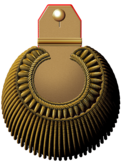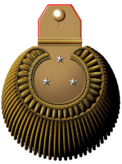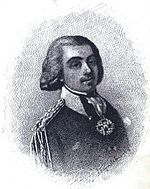Life Guard Hunter Regiment (Russia)
|
Life Guard Jägerregiment |
|
|---|---|
 City quarter with regimental church, St. Petersburg. |
|
| active | 1796 to 1917 |
| Country |
|
| Armed forces |
|
| army | Life Guards of His Majesty |
| Branch of service | Infantry , fighter troops |
| Location | St. Petersburg |
| owner | Tsar Nicholas II |
| Patron saint | Holy Miron |
| march | ... the life guard hunter |
| insignia | |
| Chest pendants |

|
The His Majesty's Life Guards Infantry Regiment , also briefly Life Guard Infantry Regiment ( Russian Лейб-гвардии Егерский Его Величества полк , body-Gwardii Jegerski Jewo Welitschestwa polk; Shortcut: Егерский лейб-гвардии полк , Jegerski body-Gwardii polk ) was a guard - Association of light infantry of the Imperial Russian Army of the Russian Empire .
The name is derived from the German noun Jäger , which stands for "охотник (hunter), стрелок (shooter)" in Russian. The personnel of the hunter troop was recruited from sections of the population with a connection to hunting or the use of firearms. The successes of Russia on the side of Austria and France in the Seven Years War (1756–1763) confirmed the advisability of this decision.
Closed combat formations were ineffective in hilly, cut-through sections of the terrain, whereas flexible, mobile units made up of well-trained, practiced and accurate shooters who acted purposefully and in concert had a clear advantage. So it came to the formation of the independent light infantry after the Western European model. Grenadiers and musketeers cut everything to pieces - Suvorov used to say - the hunters, on the other hand, shoot.
history
The history of the Life Guard Jägerregiment began in 1792 with the introduction of a new type of troops - the light infantry - under Tsesarevich Pavel Petrovich . The new troop designation was Jäger… (ru: Егер… with reference to the German noun Jäger ) and based on the development of the armed forces in Europe. First of all, suitable soldiers from the so-called Gatchino troops (ru: Гатчинские войска / Gatschinskie woiska ) in Gatchina and Pavlovsk at the gates of Saint Petersburg were concentrated in hunter companies and placed under the command of Major Anton Ratschinsky . A first restructuring took place at the end of 1793, followed by a new formation in 1794. The new uniform of the hunters , now a green camisole , was fundamentally different from the previous uniforms.
On the highest order of November 20, 1796, all units of the Gatchinsk troops were given the status of Old Guard (ru: старая гвардия; staraja gwardija). The previously independent hunter companies were combined into a hunter battalion , which was reinforced with a third company. The already existing guards units, the Semjonov Life Guard Regiment and the Ismailowski Life Guard Regiment , as well as the Life Guard Jäger Battalion were placed under one command. Since then, November 20, 1796 has been considered the foundation day.
A. Ratschinski , who was now promoted to Podpolkownik ( Lieutenant Colonel ), became the first commander of the Life Guard Jäger Battalion . In 1800 Prince Pyotr Ivanovich Bagration took his place . In 1802 the battalion was reinforced by another company . The battle of Austerlitz became a baptism of fire for the still young hunters' troops and proves their fighting value.
On May 22, 1806, the personnel of the Life Guard Jäger Battalion was doubled and the name was changed to the Life Guard Jäger Regiment . Orders were also issued to reinforce the regiment with a third battalion. In 1809, Polkownik Karl Ivanovich Bistro was appointed as the new commander. As a result of heavy battles against the Turks on September 10, 1828 near Varna, the second battalion had to be reformed. Parts of the 13th and 14th Jägerregiment were used for this purpose.
As part of a commemorative mass on the battlefield near Kulm in 1835, Tsar Nicholas I personally paid tribute to the special merits of the Life Guard Hunter Regiment . In this context, the day of the Holy Martyr Miron , August 17th, was decreed as the future holiday or day of honor of the regiment. From then on Miron was also the patron saint of the regiment, which is why the regimental church was consecrated to him in 1854. In 1855 the association was renamed the Gatschinski Regiment , which was finally revoked on the regimental day of honor in 1870.
Regimental quarters
The capital district of the Life Guards Infantry Regiment was initially in the Semyonov barracks in the street Swenigorodskaja Ulitsa (later: Old Hunter Road; Starojegerskaja Ulitsa). Later it was relocated to the specially built New Hunters Barracks on Rusovskaya Street, No. 14, No. 16 and No. 18.
The winter quarters of the Life Guard Jägerregiment , the so-called Petersburg quarters , were located on Semjonow Platz for about 100 years .
Regimental Church
As was common in Russia at the time, the guard hunters had undergone an upbringing that was loyal to them, which is why liberal ideas were hardly widespread in the officer corps . The welfare of the regiment lay solely at the discretion of the respective monarch. The building of a regimental church, which was dedicated to the saint and martyr, Miron , was seen as a sign of the ruler's benevolence and favor . Tsar Nicholas financed the construction from his own box. The church of the Life Guard Jägerregiment zum Saint Myron was in the immediate vicinity of the city quarter on the bank promenade on Obwodnyi Canal , near the confluence with the Wedensky Canal . The construction took place from 1849 to 1854 to commemorate the victorious coalition troops of the Russians and Prussians in the fight against Napoleon in the Battle of Kulm on August 17, 1813 and the day of Saint Miron , according to plans by the builder Thon, KA. The most deserving members of the regiment found here the final resting place.
The church also served as a memorial for those killed in the First World War, but was used as a storage room until early 1930 during the Soviet era, as part of the suppression of the Russian Orthodox Church . In 1934 the already damaged building and its five towers were then blown up. There is only a car wash on the currently undeveloped terrain. According to plans by the city fathers and the church, the historically valuable building is to be rebuilt at the historic site according to the original plans.
Badge of rank
Officers
| designation | Badge of rank in execution | ||||||||
|---|---|---|---|---|---|---|---|---|---|
| Years | 1857-1904 | 1880-1884 | 1857-1904 | ||||||
| Epaulette | |||||||||

|

|

|

|

|

|

|
|||
| Years | 1857-1917 | 1904-1917 | |||||||
|
Old fashion epaulette |
|||||||||

|

|

|

|

|

|
||||
|
Epaulette new fashion |
|||||||||

|

|

|

|

|

|

|
|||
| designation | Badge of rank in execution | ||||||||
| Shoulder pieces | |||||||||

|

|

|

|

|

|

|

|

|
|
| Rank designation |
Major general | Colonel | Podpolkovnik | major | Captain | Chief of Staff | First lieutenant | lieutenant | Praporshchik |
| group | Generals | Staff officer | Senior officers | ||||||
NCOs and men
| designation | Badge of rank in the version 1907–1917 | ||||||
|---|---|---|---|---|---|---|---|
| Shoulder pieces | |||||||
 
|
 
|

|

|

|

|

|
|
| designation | Badge of rank in the version 1894–1917 | ||||||
| Shoulder pieces for 1st Company (Sovereign Company) |
|||||||
 
|
 
|

|

|

|

|

|
|
| Rank designation |
Podpraporschtschik at the Felfwebel post |
Subordinate | sergeant | Platoon sergeant | Sergeant | Private | soldier |
| group | NCOs | Teams | |||||
Heads of regiments
The heads of regiments and honorary commanders from 1796 to 1917 are listed below.
| Period | Name, first name | rank | comment |
|---|---|---|---|
| November 9, 1796 - June 9, 1800 | Ratschinskij, Anton Michailowitsch | Podpolkownik | 1800 Lieutenant General |
| 06/09/1800 - 09/12/1812 | Bagration, Pyotr Ivanovich | Major general | 1809 General of the Infantry |
| November 27, 1813 - June 15, 1831 | Romanov, Konstantin Pavlovich | His Imperial Highness and Grand Duke | |
| June 25, 1831 - February 18, 1855 | Nicholas I. | Tsar of Russia | |
| 02/19/1855 - 03/01/1881 | Alexander II | Tsar of Russia | |
| 03/02/1881 - 10/21/1894 | Alexander III | Tsar of Russia | 2nd boss from October 28, 1866 |
| 11/02/1894 - 03/04/1917 | Nicholas II | Tsar of Russia |
Personalities
The following overview contains a selection of personalities who served in this regiment or who emerged from the regiment.
- Antonov, AI - Army General , member of HQ Kdo OB , Chief GenStab of the USSR 1945–1946, first CS United Armed Forces WP
- Arbusow, AF - General of the Infantry , participant in the Napoleonic Wars
- Armsheimer, JJ - Kapellmeister , famous composer
- Baiow, AK - Lieutenant General, Russian military historian
- Baratynski, JA - poet
- Baumgarten, NK - General , participant in the Russian / Turkish War 1828–1829, military educator
- Blokowski, JD - Real State Councilor, Governor of Livonia, Yeniseisk and Vologda Governors
- Gerau, BW - major general, participant I. WK, white emigrant
- Graf, EG - Lieutenant General, Head of the Headquarters of the Kosack Armed Forces, Head of the War Ministry, Member of the Military Council of the Russian Empire
- von Güldenstubbe, MAL - General of Infantry, Commanding General of the Moscow Military District
- Wrangell, KK - general of infantry, commanding general of the Kiev military district
Individual evidence
- ↑ The Church of Saint Miron on the History and Architecture of Saint Petersburg website ( Memento of November 7, 2011 in the Internet Archive )
- ↑ Only in times of war
- ↑ Only in times of war
- ↑ 1906-1911
- ↑ 1911-1917
- ↑ 1906-1911
- ↑ 1911-1917
- ↑ 1906-1911
- ↑ 1911-1917
- ↑ 1906-1911
- ↑ 1911-1917




